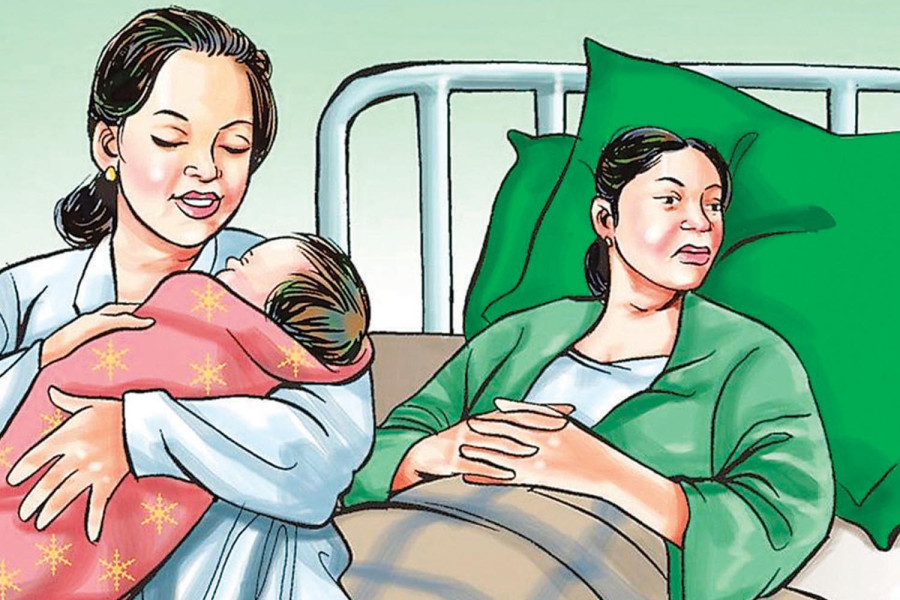Health
Budget cuts in maternal health carry serious risks, experts warn
Antenatal and postnatal care, institutional delivery, verbal autopsy of maternal deaths, and training will be impacted.
Arjun Poudel
Expansion of the maternal death surveillance programme in 12 districts is an initiative the Ministry of Health and Population plans to carry out in the next fiscal year.
Training of health workers on the prevention of pre-eclampsia (pregnancy-related high blood pressure disorders) and excessive bleeding after childbirth (postpartum haemorrhage), a major cause of maternal deaths, are programmes that are set to be impacted by a planned budget cut in healthcare.
“Along with some new and crucial programmes, ongoing ones on maternal health including institutional delivery service, antenatal care visits, and postnatal care visits, will all be affected by the budget cut,” said Nisha Joshi, an official at the Family Welfare Division under the Department of Health Services. “If the budget for these crucial programmes is reduced, more women could give birth at home.”
Officials at the Health Ministry said they have been asked to cut their annual budget by up to 42 percent which will affect most healthcare services, including maternal health.
Every year, during the course of preparing the government’s annual budget, the finance ministry asks all the ministries to prepare budget proposals for themselves and forward it to the finance ministry. Based on those proposals, the ministry prepares the national budget. The finance ministry sets a ceiling under which the ministries have to submit their proposals. This time around, the finance ministry has fixed a ceiling which is 42 percent lower than the total budget of the health ministry for the current fiscal year.
A recent new report by the National Statistics Office showed that every year, hundreds of women in Nepal succumb to preventable deaths from excessive bleeding and high blood pressure. The report also showed that in every 100,000 live births, 151 women die of maternity-related complications.
Maternal health experts warn of serious repercussions from the abrupt budget cuts in healthcare services.
“How can we reduce the budget for crucial programmes of maternal health—free institutional delivery, antenatal and postnatal care visits that have played an important role in reducing maternal deaths?” questioned Dr Ganesh Dangal, chairman of the Nepal Society of Obstetricians and Gynecologists. “This is not the right time to cut the healthcare budget.”
The Health Ministry had planned to train health workers, including doctors and nurses, on the major causes of maternal deaths and their prevention.
Conducting studies on maternal deaths is a regular duty of the authorities concerned. But a ‘verbal autopsy’ on maternal deaths is being carried out only in 42 districts.
Verbal Autopsy, or VA, is a method of determining the cause of individual deaths and cause-specific mortality fractions in populations without a complete vital registration system. For the next fiscal year, the Health Ministry had planned to extend the programme to an additional 12 districts, which will now get impacted by the budget cut.
Likewise, postnatal care visits, which are being provided by trained nurses at homes, will also be affected. The Health Ministry has been providing the services by hiring more than 1,600 staff nurses.
The government had already downsized the total budget by a substantial 13.59 percent, totalling Rs 243.83 billion for the ongoing fiscal year 2022-23, citing a plunge in its revenue collections. According to officials, it was the largest cut in the ministry’s outlay, to date. The government cited its inability to ensure necessary funding for the cut.
Officials say the country has witnessed a negative growth in revenue collection during the first six months of the current fiscal year, the first time since the fiscal year 1967-1968.
The government presents the annual budget in Parliament on Jestha 15 every year (May 29 this year).
“Signs are not good. We are being asked to significantly reduce our budget,” Dr Roshan Pokhrel, secretary for Health, told the Post. “Most of our regular programmes will be affected if the healthcare budget is slashed by such a big margin at once.”
According to officials at the Health Ministry, the massive cut in the budget will directly affect the country’s priority programmes, including those of maternal health.
With the government starting to provide free services and travel allowances, institutional delivery services increased to 80 percent, from only around 18 percent. The ministry has also been distributing misoprostol, a medication used to treat postpartum bleeding in new mothers, through female community health volunteers.
Nepal succeeded in reducing the maternal mortality rate from 539 per 100,000 births in 1996 to 239 per 100,000 births in 2016—for which the country even received a Millennium Development Goals award. The report showed that 88 maternal deaths were prevented in every 100,000 live births between 2016 and 2021. The study was carried out in 2021.
Nepal missed its own targets of reducing maternal deaths in 2020 and 2022.
The country needed to limit maternal deaths to 125 per 100,000 births in 2020 and to 116 in 2022.
Nepal’s target under the UN’s Sustainable Development Goals is to reduce the maternal mortality rate to 75 per 100,000 births by 2030.
Experts have cautioned that the budgetary cuts in crucial programmes of healthcare would have a long-term impact and affect the achievements made over the years.
“Reducing health budget at this juncture is not a good sign and will not do any good to the country,” said Dr Damaru Prasad Paneru, a maternal and child health expert, who is also an associate professor of public health at Pokhara University. “Home delivery rates will increase, which means an increase in the maternal death rate… the morale of the service providers will also go down.”
Paneru, who also heads the post-training assessment of skilled birth attendants, said that if not corrected, the planned budget cuts will have serious consequences.




 15.76°C Kathmandu
15.76°C Kathmandu















